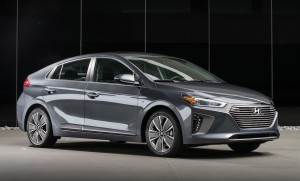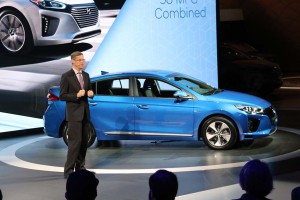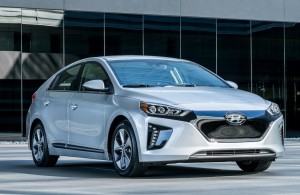Green is still a go as far as the global auto industry is concerned and Hyundai is planning to use the Los Angeles Auto Show to showcase its new family of vehicles equipped with three distinct alternative powertrains.
Mike O’Brien, Hyundai Motor America vice president of product planning, said the new Ioniq family is unique in so far as the basic platform for the battery electric, plug-in electric and hybrid. The Ioniq made its debut in New York earlier this year.
All three vehicles are built in South Korea from what is basically a common parts bin, which helps keep down costs, said O’Brien, adding the Ioniqs are the product of Hyundai’s effort to build a fleet of dedicated Green vehicles that will grow in the future.
But there are variations, the EV version of the Ioniq has a larger battery than the hybrid model, for example, he noted. The PHEV and hybrid versions are also equipped with a high-efficiency 1.6-liter gasoline engine that is designed specifically to fit into the powertrain of alternative vehicles, which is combined with a dual clutch transmission.
(Hyundai plans to sell Ioniq EV family in every state. Click Here for the story.)
The combination city/highway fuel economy of the Ioniq hybrid is expected to reach 57 miles per gallon in the Environmental Protection Agency’s combined driving cycle, according John Juriga, director of powertrain at the Hyundai-Kia Advanced Technical Center in Ann Arbor, Michigan.
But the common design of the three vehicles helped Hyundai increase the interior space of all three vehicles. All three Ioniq models will showcase Hyundai’s latest connectivity features as well as options such as automatic emergency braking, lane-departure warnings and apps for Apple CarPlay and Android Auto.
In addition, the chassis of all three of the Ioniq vehicles have been tuned so the vehicles are fun to drive, O’Brien said.
(Click Here to learn how Hyundai and Kia hope to become second in the green-car market.)
Ultimately the hybrid version, which matches up well with the Toyota Prius, is expected to be the best selling of the three Ioniqs, he noted, adding the profile of the typical buyer of new vehicles in the United States is beginning to shift and shift rapidly toward younger buyers, who are more interested in alternative vehicles and the green technology behind them than their parents.

Hyundai is also offering two hybrid models of the Ioniq. The plug-in hybrid is expected to be available next fall.
However, manufacturers have not done a very good job selling the advantages of plug-in hybrids, which can run a good distance if the battery is kept charged, O’Brien said. The name alone makes it sound like you need to stay plugged in to a wall socket to operate properly.
“We have to do a better job marketing the plug-in (hybrid),” he said.
(To see more about Hyundai’s plans to blitz the market with 26 new “green” machines, Click Here.)
O’Brien said the Ioniq EV will be ready for sale by the end of the year and the hybrid will go on sales early in 2017. The plug-in hybrid will be available next summer.



Ioniq Dodge Dart special edition.